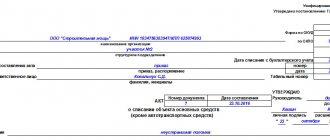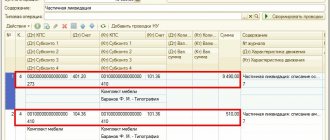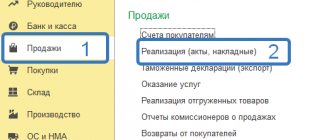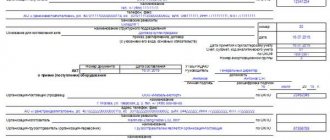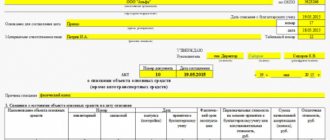Fixed assets - what are they?
Fixed assets include any property with which the company carries out its activities: equipment, machinery, inventory, materials, transport, instruments, etc. Buildings and structures are also fixed assets, just like raised livestock and some types of plants.
But those items or products that are in warehouses and are planned for further sale, as well as those that are in the transportation stage, are not considered fixed assets.
In what cases should I fill it out?
The transfer and acceptance certificate OS-1 is drawn up when the need arises to transfer an object classified as a fixed asset of an enterprise for the use of another organization (sale, exchange, leasing) or to put it into operation.
Fixed assets are objects whose useful life in the course of the economic activity of the enterprise lasts more than 12 months, as well as plots of land, equipment, inventory, vehicles, livestock, and computer equipment.
Acceptance of buildings and structures is documented in the standard form of act OS-1a. For other single objects, the unified OS-1 form is used. For groups of objects - form OS-1b.
Construction projects can be classified as fixed assets only after completion of construction work or acquisition of a finished building.
We also recommend reading:
- construction of fixed assets by contract;
- creating an operating system in an economic way.
The transfer and acceptance certificate is used in accounting, which fully reflects information about the fixed asset.
For example, when purchasing material assets that need to be put on the company’s balance sheet as fixed assets, the transfer act serves as the basis for the fact of write-off by the seller, and for the buyer to reflect the acquisition in accounting.
The purpose of the act in form OS-1
An act is drawn up when transferring an object of fixed assets (one or more) from an organization to another enterprise, in order to implement the terms of any agreement.
It does not matter who the parties to the transaction are: legal entities or individual entrepreneurs - the act must be drawn up regardless of this.
The creation of an act mainly pursues one goal: to record the fact of the transfer of fixed assets.
In addition, on the basis of this document, organizations register the transferred inventory items for accounting and put the property into operation.
The act of acceptance and transfer of fixed assets is an annex to the contract and in the future, in the event of any disagreements, it can become evidence in court on both sides.
Certificate of acceptance of equipment transfer for installation - form OS-15
In some circumstances, enterprises have difficulty drawing up a report on received equipment that must be installed. Despite the apparent similarity with the form described above, a different OS-15 form is used here.
When receiving equipment for installation purposes, it has its own path: first of all, it goes to the warehouse, then it is assembled, and after testing, the object is transferred to the category of fixed assets.
Form OS-15 is issued when the equipment is installed at the enterprise. Filling out the form is not difficult, since it contains a standard set of details, lines and columns. This form is available on our website.
Is it necessary to create a commission?
As mentioned above, two organizations always participate in the acceptance and transfer of fixed assets. Moreover, in some cases, an entire commission is created to carry out the procedure and draw up the act.
This is usually necessary when the property (for example, equipment or instruments) has complex technical characteristics . To ensure that it is transferred in proper quality, working condition and without any breakdowns, defects or defects, third-party experts are sometimes included in the commission.
Key points when filling out form OS-1
The act applies to primary documentation, for which strict requirements have been abolished since 2013. Therefore, today, enterprises and organizations have every right to draw up a document in any form, use a template approved within the company, or fill out a previously mandatory standard unified form. The last option is convenient because it includes all the necessary information; you do not need to rack your brains over the structure and content of the document.
The required information in the act includes:
- creation date and number;
- details of enterprises;
- the name of the fixed asset, as well as everything related to its quality and quantity.
If the recipient of the property has no claims against the supplier, this must be noted; if such claims exist, they must be described in detail.
What to pay attention to when drawing up a deed
Information can be entered into the document either on a computer (if an electronic form is available) or by hand (with a ballpoint pen, but not a pencil).
An important requirement that must be met: the presence of signatures of heads of organizations or representatives acting on their behalf (the use of facsimile signatures is unacceptable).
There is no strict need to certify the form using stamps, since from 2021 legal entities have the right to use seals and stamps in their work only on the condition that this norm is enshrined in their internal regulations.
The document is created in at least two copies (one for each party to the transaction), but additional copies can be made if necessary.
How to fill out the act form
The act of acceptance and transfer in itself is not a self-sufficient document, but serves as a mandatory annex to the relevant agreement (donation, exchange or sale).
Some subtleties:
- At the top of the first sheet, the details of the parties and the names of the managers (authorized persons) are typed or written in with a fountain pen (ink, paste, but not pencil). Who is on the right or left does not matter, the sides are equal.
- Stamps are not required.
- Facsimile prints are not acceptable.
- The number of copies is two or more, depending on the specifics of the document circulation accepted at the enterprise.
There are no other nuances, and in case of difficulties, you can always look at a sample of filling out the acceptance certificate that corresponds or is as close as possible to the current situation:
The no claims clause is rightfully considered an important point. It is in the OS-1 form, but authors of independently compiled forms may forget about it.
OS-1 forms
Commission
The above acts must be signed by managers or persons appointed by them (by order). However, situations arise when the equipment being received is so technically complex that specialized knowledge is required to determine the degree of its performance.
In this case, the following options are possible:
- Involvement of independent experts;
- Creating your own commission.
It is possible to form a joint body whose task is to come to a consensus on:
- Wear of the product;
- Its ability to perform its production function;
- Maintainability.
All identified defects or malfunctions are entered in the “brief description” column on the back (or second sheet) of the acceptance certificate. If everything is in order and in good working order, then it is simply written: “No complaints.”
Sample of registration of the act of acceptance and transfer of fixed assets
Filling out the first page of the act
- At the beginning of the document, space is allocated for its approval by the heads of the enterprises between which the acceptance and transfer of fixed assets takes place, indicating their positions and the date of approval.
- Next, enter data about the recipient organization: its full name, address, information about the current account and the bank in which it is opened. Similarly, information about the company that transfers the property is entered into the form.
- In the line “Grounds for drawing up the act” a link is given to the agreement - its number and date of creation.
- After this, two more dates are entered into the act: acceptance of the fixed asset for accounting and its write-off. This also includes the account number through which all actions with this property take place and its inventory, factory, and depreciation numbers.
- At the end of the registration of this part, the act is assigned a number, the date of its preparation is indicated, the name of the transferred property, the location of its actual location at the time of acceptance and transfer, and the manufacturing organization are written.
All other information is entered as needed.
Filling out the second page of the act
The second page of the act includes three tables:
- The first contains information about the condition of the fixed asset at the time of acceptance and transfer: date of release, commissioning, repair, actual time of use, amount of depreciation, residual value and purchase price under the contract.
- The second table includes information about the object as of the date of acceptance for accounting: cost, remaining useful life and method of calculating depreciation.
- The third table concerns some features of the property, including the presence of precious metals in it.
Filling out the commission decision and signatures of the parties
The next part of the document includes the date, as well as the results of tests of the transferred property and the conclusion of the commission present at the acceptance and transfer.
If there are any attachments to the document (for example, an expert’s opinion), this must be noted in a separate paragraph.
At the end, the act is signed by all members of the acceptance commission, as well as managers and chief accountants of enterprises.
In what cases and when is it used?
The unified form of the OS-1b act is used by the recipient organization for:
- inclusion of property in the form of a group of homogeneous objects in the fixed assets (their accounting and commissioning), acquired under sales contracts or for cash;
- when registering a financial lease (when the property is on the balance sheet of the lessee);
- when unaccounted for property is discovered during the inventory or manufactured in-house or with the help of contractors;
- exclusion from the OS of a group of objects during exchange, sale, donation, or transfer to another enterprise.
Important! The donating organization issues the OS-1b form only when exchanging, selling, or gratuitously transferring fixed assets.
For objects that do not require installation, the start of operation occurs at the time of purchase. If installation is necessary, then inclusion in the OS is carried out after the equipment assembly process. Initially, the property is accepted according to the OS-14 act, after which they are transferred for installation on the basis of the OS-15 form.
